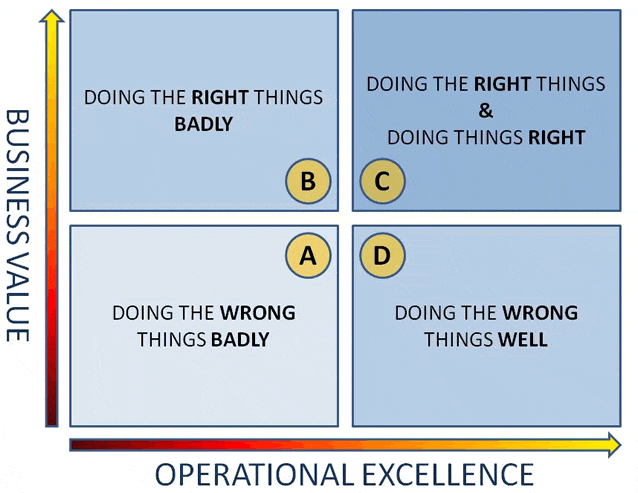Meeting Business Needs: Doing the Right Things and Doing Things Right

Good business-IT alignment (please note that I use this well-known and oft-used phrase reluctantly as IT is part of the business) relies on two things: doing the right thing and doing things right. Without both of these, what IT does will never live up to what business colleagues and stakeholders need and expect; where:
- Doing the right things” means executing IT initiatives that support business strategy.
- Doing things right” means executing these initiatives in a way that delivers the proposed value within the required timescale and cost constraints.
How Does IT Normally Fare?
In my opinion, IT can sometimes do the wrong things badly. But it’s less common for IT to do the right things well, at least in the eyes of business colleagues.
The two key factors here are business-IT alignment and operational excellence. When there is a disconnect between the business and IT there can be a reduction in the business value generated, even if IT is run very efficiently. And if IT has issues with its operational efficiency, it may struggle to deliver value to the business, even if it does know what the business needs.
This can be represented in a simple matrix that shows IT maturity in the context of business alignment and IT operations.

So What Can IT Organizations Do?
Organizations want and need to move up and to the right (into quadrant C), with this desire driven by different instincts on either side of the divide. The IT department wants to focus on new infrastructure and improved operational efficiency, because that’s what they care about. They want to move across the matrix from left to right. The business wants IT to “stop messing around with the shiny technology” and to give them what they really want (or at least what they think they want). They want IT to move up the matrix. They want more business value from IT.
Unfortunately, many IT organizations (being more focused on the “how” rather than the “what”) will take a path from A through D to C. However, the preferred path would be to do the rights things slowly and then ramp up efficiency over time (going from A to B to C) as this will have a more immediate impact on the business value delivered, not to mention reducing the money spent on things that are potentially irrelevant to generating business value.
Which quadrant is your organization in?
Quadrant A
IT organizations in quadrant A suffer from a combination of poor processes and poor strategic alignment with the business. From here, IT has a lot of ground to cover. Simultaneously improving business value and internal operational efficiency is tough, so IT will need a solid improvement roadmap outlining the key priorities. The catch-22 is that the business may have little faith in IT, making it difficult to get the budget and manpower needed to get out of the “firefighting mode” and take steps to increased maturity.
Quadrant B
Organizations in quadrant B have good alignment between IT and the business, but suffer from poor execution. They understand what the business needs, but immature capabilities and processes are preventing them from delivering value quickly, efficiently, and with minimal risk to current business operations. This means the output can be frequently late, over budget, and below the level of quality the business needs. For organizations in quadrant B, implementation of best practices (such as ITIL®, the IT service management best practice framework, will help to give them the efficiency boost they need to execute delivery more quickly.
Quadrant C
Quadrant C is where IT organizations need to be, combining a good understanding of what the business needs with a solid supporting IT strategy and good execution capabilities. However, this is not an end point; there will always be room for improvement. IT organizations in this quadrant will have a clear track record of delivering business value fast, so the perception of IT will be considerably more favourable. This will make it easier to work with business stakeholders and get additional budget for improvement.
Quadrant D
With established processes and capabilities, IT departments in quadrant D are moving fast — but in the wrong direction. It’s a common situation for IT departments that put too much focus on implementing a best practice framework like ITIL. Efficiency goes up and the internal IT metrics look good but IT has effectively disengaged from the business at a strategic level. To get back on track, the IT department needs to re-engage with business stakeholders, implement business value metrics to measure performance, and institute IT customer satisfaction surveys to keep a gauge on the business’s perception of IT.
Mature IT organizations that measure business value and operational performance will be able to use their metrics to quickly place themselves in the matrix. However, the majority of organizations that actually have suitable measurements are more likely to already sit near the top-right.
Organizations with lower IT maturity should be able to establish their position by consulting the business directly. Do business stakeholders feel that they have the right services and technology to do their jobs efficiently and effectively? Are IT projects delivered quickly enough? Do IT expenditures balance well against business value delivered? Do changes to the IT infrastructure frequently have an adverse impact on business operations? Is IT responsive when something goes wrong?
The matrix is a tool for IT to plot its maturity level from an alignment perspective, frame conversations with internal and external stakeholders, and hopefully crystallize a commitment to moving in the right direction. With it, IT can identify whether it needs to improve internal operational efficiency, develop a better understanding of business strategy, or both. The path to business-IT alignment begins with a shift in the mentality of IT — from devices, infrastructure, and processes to customers, services, and value.
Like this article? You may also like: 4 Things You Need to Know About IT Maturity Assessments
Please share your thoughts in the comments or on Twitter, Google+, or Facebook where we are always listening.
Did you find this interesting?Share it with others:
Did you find this interesting? Share it with others:








